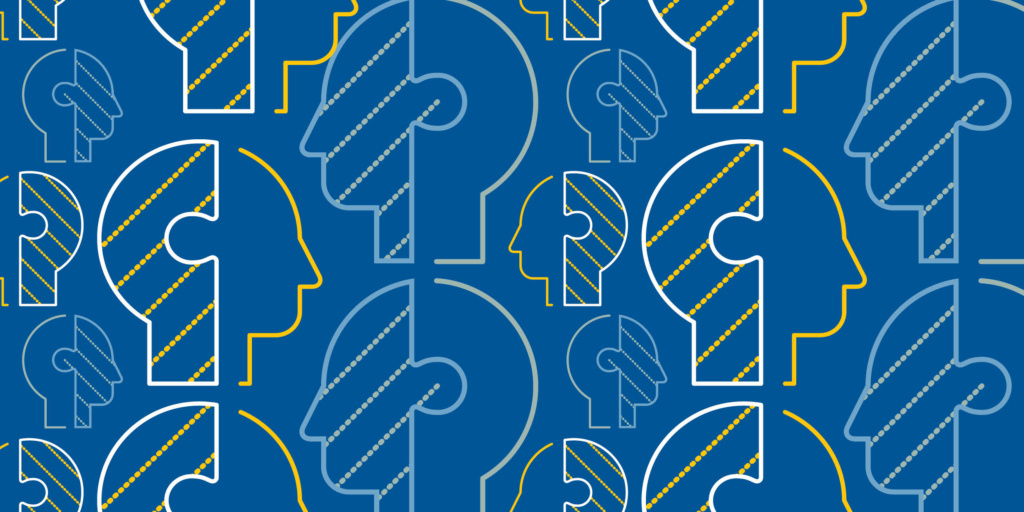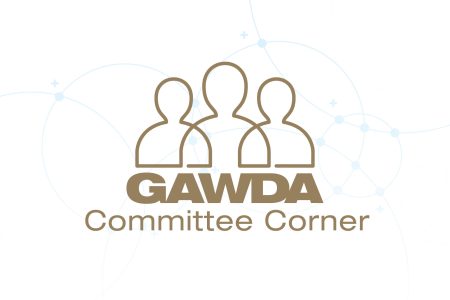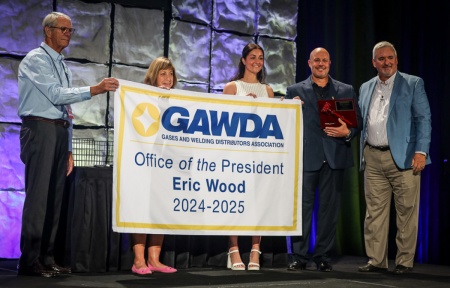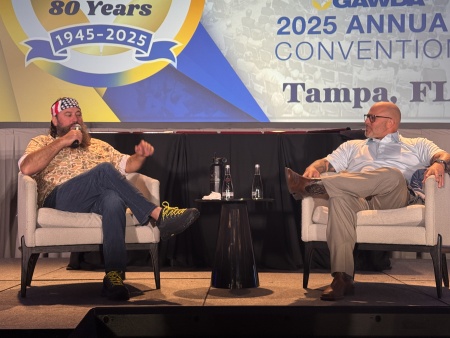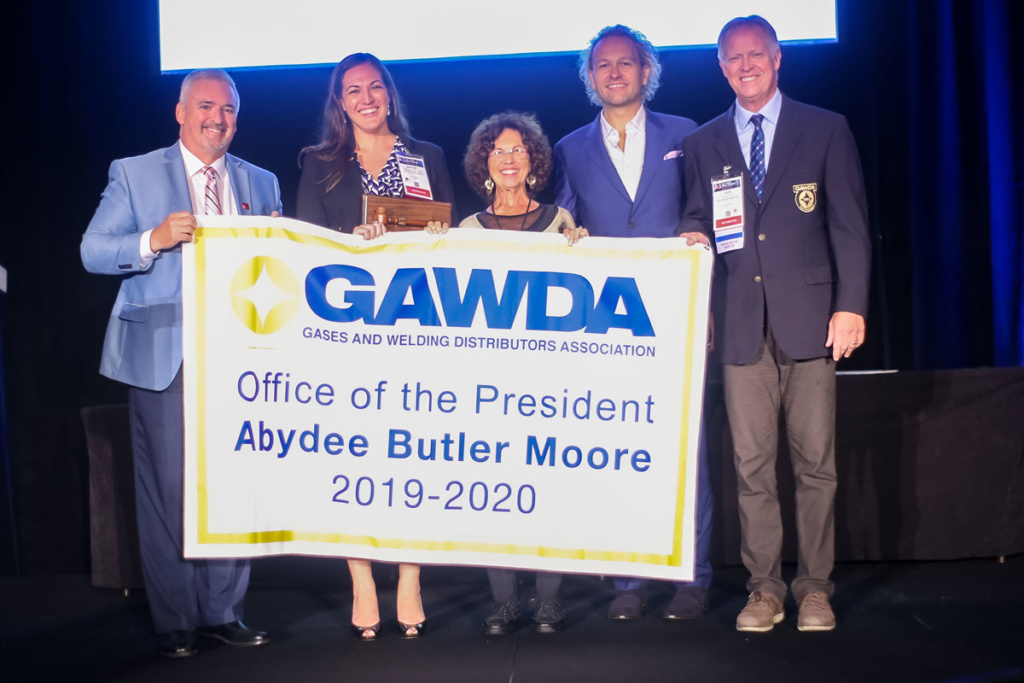
by abydee butler moore, brad peterson, ned lane, mark raimy, bill visintainer and tom biedermann
At the 2019 GAWDA Annual Convention in Washington, D.C. Abydee Butler Moore officially ascended to the position of president of GAWDA. After the ceremony, which saw her get escorted to the stage by the GAWDA Past Presidents in attendance, Abydee laid out her “2020 Vision” for the association next year. However, the guided escort to the stage was more than a symbolic gesture. The past presidents who guided her to the stage have all stood where Abydee was about to stand and dealt with many of the same pressures and challenges that she will be facing in the upcoming year. And every single member of the Past Presidents club stands by, willing and able to answer any questions or share any advice with Abydee based on their past experiences. For this feature, Abydee contacted her five immediate predecessors with questions about the position she has just recently inherited. We thank Brad, Ned, Mark, Bill and Tom for their input and participation.
Abydee Butler Moore: Thank you for serving the industry as GAWDA President and for paving the way for others like me. When you look back on your year, what is your most memorable moment?
Brad Peterson: The most memorable moment was the opening reception for the SMC in Minneapolis. The weather was perfect, the river and the city were a great backdrop, and everyone seemed to enjoy themselves. I had worried about everything that could go wrong (including snow), but it all came off very nicely.
Ned Lane: For me, the most memorable moment was the announcement of the GAWDA Gives Back match and the unbridled emotion of the Mary’s Place representative. Pure joy and appreciation.
Mark Raimy: I would say the opening reception of the SMC in Boca Raton. That was most memorable to me because of the change in format that kept everybody together the whole night.
Bill Visintainer: My induction, particularly being led to the podium by the former presidents. I was filled with a sense of purpose and appreciation for all of the men and women who have selflessly given their time and talent to make GAWDA an outstanding resource for all members.
Tom Biedermann: Well, the most memorable moment, to me, was completing our transition from the AWS managing us to our independence. I followed in the footsteps of Craig Wood and Ned Pontious. I was able to be the one to complete that process and open the new office down in Hollywood.
ABM: What are you most proud of achieving for GAWDA?
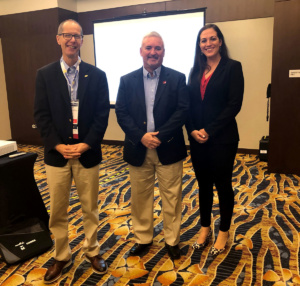
BP: I’m proud to have done my part in keeping the organization moving ahead with new staff members and continual improvement in our processes.
NL: Setting us on the path of measuring and documenting the value we deliver to our members. Having facts and figures in making decisions for the organization vs. what we may think is happening. Let the numbers lead the process. If you measure it, it will improve. Overall analysis of staff and workload to allow for the addition of Andrea Levy to help spread the workload and establish some member engagement metrics. Getting to bring the SMC to St. Louis was another proud moment. Many members had not visited the city and got to experience what our city has to offer.
MR: Establishing ITR Economics as our chief economists. Macroeconomic forecasting is one of the most powerful business tools that is available to help us make decisions. It’s not just for the top of the company, it’s for all levels of the company. Either fortunately or unfortunately, where people will find the most value for this is when there is a flattening or downturn of the economy. I was fortunate enough during my time as president to not have dealt with that part of the economic cycle. But if you have been lingering on the sidelines or not really too sure how to use the ITR Report, now is when you should start paying attention because now is when it will be the most helpful.
BV: I’m proud to have played a small role in the successful conversion to an independently run association.
TB: I agree with Bill, that was such a proud moment to be able to say that we’re actually independent and to complete the process that was started by Woody and Ned. I’m very fortunate to have been put in that position.
ABM: If you could have one do-over from your year as president, what would it be?
BP: That’s a big one. If I could be president in a different year from building an Air Separation Plant, that would improve my attention to both projects. Both of them were long-term commitments, they just happened to occur simultaneously.
NL: Similar to Brad, we had a lot going on at Cee Kay the year I was president of GAWDA. I wish I would have had the time to travel to all the regional meetings across the country.
BV: I would not take a do-over. Everything did not always go perfectly as planned during my year. We experienced both successes and failures. I believe that all things come together for a purpose, we learn from our mistakes and we improve from our successes.
MR: I agree with Bill, I wouldn’t take a do-over.
TB (laughing): I’d do it all over again! I would absolutely be willing to be GAWDA president again. It was such an absolutely excellent experience. Very fulfilling. I met a lot of people, I got to know a lot of people. And I would just do that whole process once again if I didn’t have to get my wife and my partners involved. They stood behind me 100%.
ABM: At what point in your career did you determine that GAWDA volunteerism was the right path? What or who influenced you?
BP: I’ve always thought that if you’re a member of a group, that at some point you step forward. This attitude was instilled in me by my parents, and I can vividly remember walking the sidewalk in Chicago with my father on our way to the GAWDA meeting. Specifically, I stepped forward with GAWDA when I retired from my Navy Reserve career. I just didn’t have the time up until that point.
NL: Tom Dunn, the owner of Cee Kay, had always been open to sharing our successes and failures with other distributors. The networking at the GAWDA events allows you to build relationships and be open to share.
MR: I would say the first GAWDA meeting I attended, which was an SMC in Dallas. Once I saw the interaction and the resources that were available in one room and one Convention over a couple of days, it was pretty clear to me that you had to be deeply involved in this.
BV: I attended my first NWSA Annual and Zone Meetings in 1984. I was very young and had lost my mentor, my father, a year earlier. I learned this industry from NWSA/GAWDA meetings, speakers and fellow members. For the first five years attending NWSA/GAWDA, I was a net “taker” and “zero” contributor. Eventually, I was challenged by some of our supplier and distributor members to restart a Birmingham Regional Meeting that had gone dormant for years. From there, I was asked to serve on the Management Information Committee, Board, Executive Committee and as president. I am still a net “taker” of GAWDA benefits, but I try to payback wherever I can.
TB: When I was transitioning into management of our company, I was given the opportunity to go to NWSA at the time. I was so impressed with the whole function; The attendance, the people who were just pleased to be there. I volunteered right off the bat. I worked in committees. I was on the board several times. I was asked a couple of times if I wanted to be president, but it wasn’t right for my family. When it became proper and right for my family, my wife and I talked about it and we jumped in.

ABM: What does it mean to you to serve the industry and our Association?
BP: It means that I contribute to the well-being and positive image of our organizations. It’s a responsibility and a privilege to be a representative and ambassador.
NL: It was important to me to give back to the industry that has been so good to my family and I over the past 35+ years.
MR: It’s humbling and gratifying to be able to give back and be a steward. Stewardship was a big thought process I had when I approached this role. And then, to be able to have that responsibility, and to be able to, at least incrementally, make it a little bit better or different than when you did it and have some of those changes be long-lasting, it’s beyond gratifying.
BV: It is my honor, my privilege and my responsibility.
TB: I enjoyed doing every bit of it. From just being a committee member to a committee chair to the board. It was something that I didn’t realize I would enjoy doing. My dad was a big influence. My dad was a past president of NWSA. He encouraged me to continue on and I’m really glad that I did.
ABM: What advice do you have for those like me walking in your footsteps?
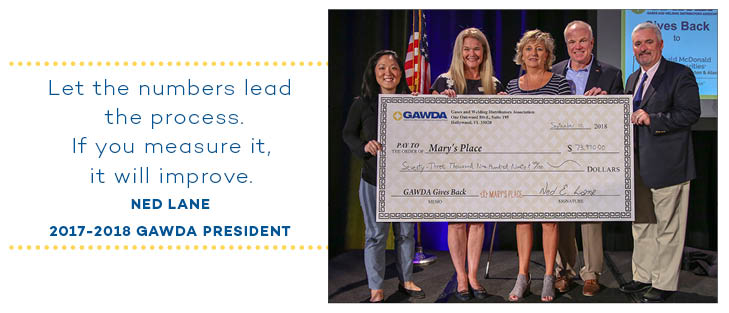
NL: Enjoy the ride! It is hard to get everything done in one year. Be confident that the projects or changes you implement will have a lasting impact on GAWDA.
MR: My advice is two-fold. GAWDA is at its best when we all come together and learn from each other. I think as long as you have that theme or that thought process in every decision you make, you’re going to make a good decision. One of the beauties of having presidents is that there are things that we all kind of work on and continue, but it’s an opportunity for you to do something that you think is good for the association. So, make sure you take advantage of that opportunity. Trust in yourself and dare to be dynamic and take some risks.
BV: Just take some time to smell the roses and enjoy the journey.
TB: Like everybody else said, take it all in and enjoy every minute of it. It’s a lot of work. It’s a lot of time. And it’s time away from the office and the family. However, doing what we’re doing for the industry to keep our industry alive and viable is very, very important.
ABM: Which fellow past president showed you the ropes? Who was on your speed dial?
BP: Basically, any past president has been more than happy to answer my questions. In fact, I’ve talked to at least ten…I was tracing the history of some matter and just started calling them in order. Ned Lane and Bill Visintainer showed me the most “nuts and bolts” of things. They were current on the issues, and I saw them at every executive committee meeting. It’s a good structure to have past presidents involved.
NL: Mark Raimy and I spoke a lot. We had a lot of projects that took both our years to get completed. Though he is not a past president, John Ospina and I spoke weekly. His passion for GAWDA and his team gave me motivation to work with the Board to make and implement changes.
MR: The overwhelming message that I got is that any and every past president was available for anything that I needed. And that was clear as a group. It was clear individually. Whether you knew them a little bit or didn’t know them at all. So, I did take advantage of that from time to time and spoke to people that I never would have had the opportunity or felt comfortable enough to give a call to talk to. My three, in particular, would be: Jack Butler, Bill Visintainer and Randy Squibb.
BV: Bryan Keen, Craig Wood, Jack Butler and Lloyd Robinson were the past presidents who most “showed me the ropes.” The three people on my speed dial were probably Jimmy Walker, Natasha Alexis and John Ospina.
TB: Of course, my dad was someone I relied on. And Craig Wood was very influential in helping me make my decision. Woody and I have worked together in several different industry functions. I have a lot of respect for Woody and he and I had long conversations on the phone regarding this. He is more of a mentor to me than anybody really, outside of my family.
ABM: What shows in your GAWDA crystal ball 10 years from now? What does our industry look like?
BP: Wow. Tough question. A constant swing of the pendulum from one side to the other. Majors acquiring and divesting. Independents starting up and rolling up. More technology. More interconnectedness. More efficiency.
NL: I believe that there will be less Gas & Welding distributorships. Our membership roster may also consist of members that are more niche companies: Bev-Carb/Dry Ice/Cannabis Gas/Propane companies.
MR: I see more of the same. If you look back through history, there have always been “systemic threats” to our industry. If you go back decades, there has always been something. But the thing that has been constant is the people and the willingness to get together and learn from each other. Distributors, suppliers, different generations, you name it. It’s just a tremendous opportunity that at the core strengthens our industry.
BV: I think we’ll see more of robotics, automation and artificial intelligence. I see expanded gas applications and strong growth in food, beverage, medical and specialty. On the other hand, I expect fewer small fabricators, fewer distributors selling hardgoods only, and fewer requirements for humans with CDL and HAZMAT.
TB: I think we’re looking at more compliance and more regulation. I think we’re going to be looking at more governmental involvement. Safety is a major issue and I think that will continue. It should be foremost on everybody’s mind as far as our industry is concerned. We’re a very safe industry and we have very few accidents compared to other industries. The potential of our industry is immense. I think the FDA will come down on us a little bit more, now with the food and medical gases. They don’t really know what to do with our industry at this point. It’s so different than what they are used to. I think that’s where we’re heading. And it will make doing business a little bit more difficult.
ABM: What is your rallying cry to our membership? As you are influencing others to serve, what is your message?
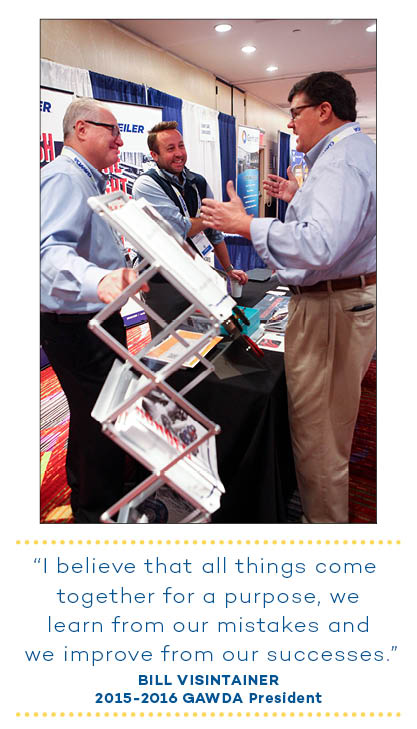
NL: Get involved. The time you put in will come back double in benefits. If you are able to network and build relationships, it will have a positive effect. Rarely at Cee Kay do we have a challenge that I cannot reach out to another member who has faced something similar and they are always willing to provide their experience/guidance.
MR: Get involved and stay involved. An example I use is that in my company, if a problem gets to me it’s usually complex. And people in our company might be having a hard time solving it. And more often than not, I find my resources and my answers from my GAWDA rolodex. From people that I have met at the Contact Booth program or at a social event or the receptions. That’s a huge resource.
BV: You might be able to go it alone, but it will be significantly more expensive and definitely less sustainable. Our industry needs us as much as we need our industry.
TB: Help us out. Help the industry out. By helping the association, you’re widening the scope of the industry as well as becoming more and more of an industry advocate. You’re widening the horizons of the industry as well as your own. You’re growing with the association and the industry.



